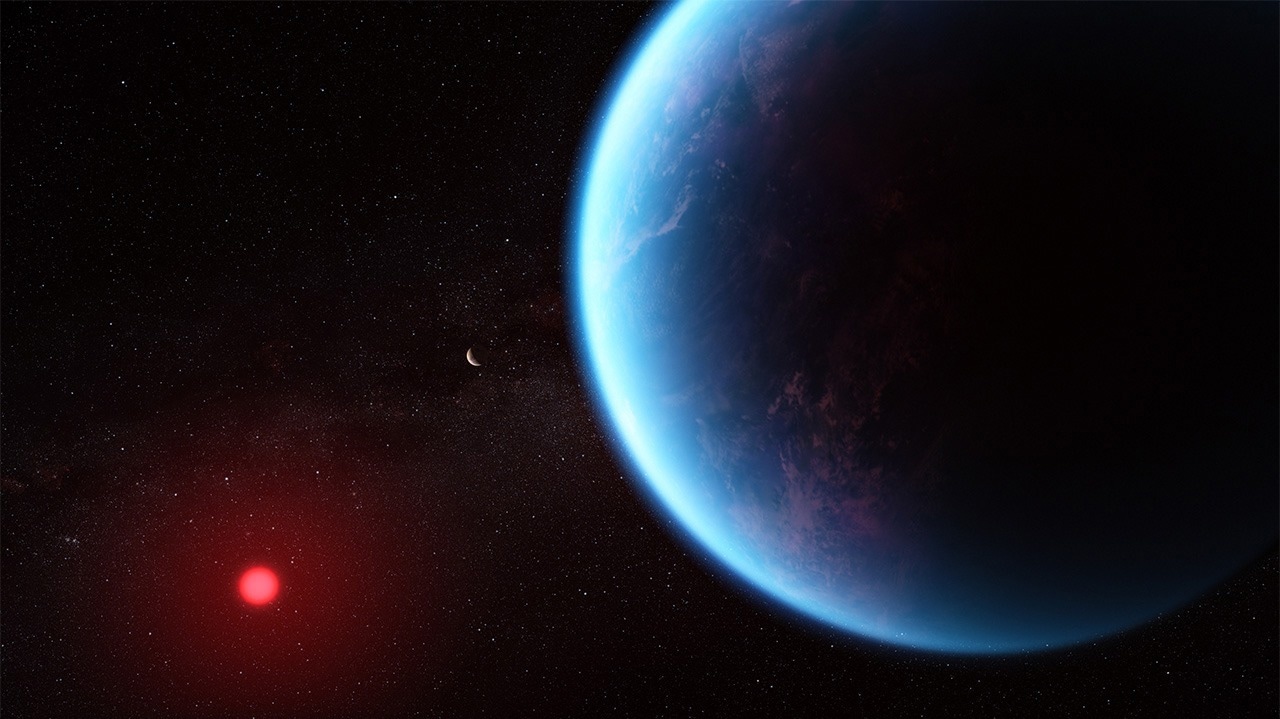The relatively small masses, sizes, and lower temperatures of M dwarfs create favorable conditions for studying planets in relation to their host stars. Among them, K2-18b is a well-known planet with about 8.6 times more mass than Earth.
This article will focus on the recent discovery by the scientists of NASA’s James Webb Space Telescope, who detected the presence of carbon-based molecules, namely methane and carbon dioxide. This is a huge discovery that might suggest the potential for suitable conditions for the occurrence of life and the potential existence of oceans.

Image Credit: NASA, ESA, CSA, Joseph Olmsted (STScI)
What is K2-18b?
K2-18b was discovered in 2015 and is classified as a super-Earth exoplanet. It is orbiting an M-type cool dwarf star titled K2-18. It completes a single revolution around its host star in approximately 32.9 days and maintains a distance of about 0.1429 astronomical units (AU).
An article published in Experimental Astronomy reveals some major information about the atmospheric buildup of K2-18b. The researchers have stated that an examination of K2-18b has resulted in a noteworthy finding confirming the existence of water vapors in its atmosphere.
However, the analysis of the Hubble Space Telescope (HST) WFC3 spectrum has proposed three distinct potential scenarios with varying characteristics. These three solutions encompass a primary atmosphere characterized by cloudiness with hints of water vapor (resembling a cloudy sub-Neptune), a secondary atmosphere containing a substantial quantity of H2O, reaching up to 50% volume mixing ratio (resembling an icy/water world), and the possibility of an undetectable gas like N2 (similar to a super-Earth).
Experimental Research on the Interior of the K2-18b Exoplanet
The Astrophysical Journal has a research article focused on the examination of the interior and atmosphere of K2-18b. It has a bulk density whose value is between that of Earth and Neptune; it is a high possibility that K2-18b consists of a purely rocky or icy interior along with a hydrogen-rich cover.
The research team conducted an extensive analysis of both the atmospheric and internal characteristics of K2-18b, considering its overall features and its atmospheric transmission spectrum. Their investigations led them to determine that the planet's atmosphere primarily consists of hydrogen (H2), with a water vapor (H2O) volume mixing ratio ranging from 0.02% to 14.8%, aligning with findings from prior studies. Additionally, they observed a scarcity of methane (CH4) and ammonia (NH3), indicative of chemical disequilibrium.
Utilizing data on bulk properties and inferred atmospheric attributes, the researchers further narrowed down the planet's internal structure and thermodynamic conditions. They noted that at the surface of the H2O layer, these conditions span a range from super-critical to liquid phases, offering a spectrum of potential scenarios conducive to habitable conditions on K2-18b. This outcome underscores the possibility that habitable conditions may not be confined solely to Earth-like rocky exoplanets, expanding our understanding of habitability in diverse planetary environments.
Latest News
The discovery of Methane and CO2 by the James Webb Telescope suggests that K2-18b might be one of the Hycean exoplanets. Such exoplanets have an inherent Hydrogen-abundant atmosphere and a surface covered with ocean water.
In the past, the quest for signs of life on exoplanets primarily concentrated on smaller rocky planets. However, the larger Hycean bodies offer significantly enhanced opportunities for studying their atmospheres. Notably, the initial observations made with the Webb telescope hinted at the potential presence of a molecule known as dimethyl sulfide (DMS). On our home planet, Earth, DMS production is exclusively attributed to biological processes. The majority of DMS found in Earth's atmosphere originates from phytoplankton thriving in marine environments.
The identification of DMS, while intriguing, requires further confirmation to establish its presence conclusively. Although K2-18b is situated within the habitable zone and is now confirmed to possess carbon-bearing molecules, it is essential to note that these factors alone do not guarantee the planet's ability to support life.
What Challenges Were Faced by the NASA Team?
Efforts to characterize the atmospheres of exoplanets, such as K2-18b, by discerning their gas compositions and physical conditions represent a highly active field within astronomy. However, this undertaking comes with significant challenges, mainly due to the overwhelming brightness of their much larger parent stars, which can obscure exoplanetary observations.
The research team analyzed the emitted light spectrum of the dwarf around which K2-18b revolves. Since it is a transiting exoplanet, the team was able to record a significant reduction in the star's brightness when the planet passes in front of it.
As the light passes through the atmosphere of planets like K2-18b, several variations occur, leading to changes in the characteristics. These alterations are studied in-depth which provide invaluable insights into the composition of gases within the exoplanet's atmosphere.
The team at NASA is now motivated more than ever to bolster the credibility of their discoveries and gain fresh insights into the environmental circumstances prevailing on K2-18b by using new means of analysis, such as spectrographic approaches. This will uncover more essential information, leading to significant progress in the field of astronomy.
More from AZoQuantum: A Galaxy Cluster Collision That Defies the Standard Cosmology Model
References and Further Reading
Lagatta, E., 2023. 'A promising step:' NASA says planet 8.6 times bigger than Earth could support life. [Online]
Available at: https://www.usatoday.com/story/news/nation/2023/09/12/nasa-exoplanet-water-life/70830603007/
[Accessed 14 September 2023].
NASA , 2023. Webb Discovers Methane, Carbon Dioxide in Atmosphere of K2-18 b. [Online]
Available at: https://www.nasa.gov/goddard/2023/webb-discovers-methane-carbon-dioxide-in-atmosphere-of-k2-18b
[Accessed 13 September 2023].
Madhusudhan, N. et. al. (2020). The interior and atmosphere of the habitable-zone exoplanet K2-18b. The Astrophysical Journal, 891(1), L7. Available at: https://www.doi.org/10.3847/2041-8213/ab7229
Changeat, Q. et. al. (2022). Disentangling atmospheric compositions of K2-18 b with next generation facilities. Exp Astron 53, 391–416. Available at: https://doi.org/10.1007/s10686-021-09794-
Disclaimer: The views expressed here are those of the author expressed in their private capacity and do not necessarily represent the views of AZoM.com Limited T/A AZoNetwork the owner and operator of this website. This disclaimer forms part of the Terms and conditions of use of this website.